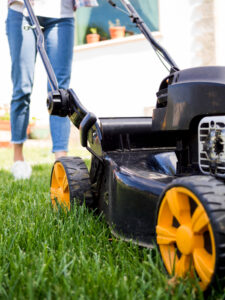Why Does Your Lawn Need Quality Care?
 Two regular and vital lawn care procedures are watering and mowing. Regular means constantly.
Two regular and vital lawn care procedures are watering and mowing. Regular means constantly.
Watering 3-5 times a week, cutting 1-3 times a week. Everything else (piercing, feeding, combing) is seasonal.
First, you need to understand that the lawn we are familiar with, and the most common is an English lawn made from a mixture of cereal meadow grasses (ryegrass, bluegrass, fescue, bentgrass).
Types of lawns (grounds, sports, games, etc.) depend on the combination and proportion of grasses.
So, the frequency of watering and mowing depends on the type and quality of the lawn.
So, how does the lawn fare? First, lawn grasses consume nutrients, water, oxygen and carbon dioxide to grow. Stems, grass leaves and roots grow. And this is where the most interesting thing lies.
If the grass is not cut, the cereal grass will begin to grow into a stem and eventually begin to spike like wheat. This is a cereal. At the same time, the growth of roots and leaves slows down since all the energy goes into the stem and future spikelets. Over time, we will see the surface of the lawn turn into bumps. For this reason, the grass needs to be cut.
When we cut the grass, the roots begin to grow in width, giving birth to new shoots. And then the lawn becomes compacted. Bald spots are growing. It is due to this procedure that the lawn looks like a carpet. It is clear that, as a result, the grass absorbs more nutrients and water.
We now understand the vital importance of watering and trimming.
Watering.
You need to water the lawn by simulating rain. This is called sprinkling. Watering with a hose from your hand will lead to the fact that the lateral roots (which appear during cutting) will begin to become exposed and we will not get the desired effect.
For this reason, sprinkler sprinklers are specially designed for lawn watering. They can be very, very different: with a larger or smaller coverage radius, with watering in a circle, in a sector, etc. But most importantly, they all provide sprinkling. When at rest, the sprinklers are buried in the grass and are not visible. When pressure appears in the pipe, the sprinkler crawls out like a telescope and waters.
How to ensure regular watering? If you don’t eat on time or don’t drink water, you will feel discomfort. So is the lawn. Bothering your head with this is unnecessary. And that’s why there are automatic watering controllers. A small device that will greatly simplify your life.
 To ensure that the entire surface of the lawn is covered with watering, it is necessary to position the sprinklers correctly. In order for sprinklers to work properly, it is necessary to select the correct pump, pipes, valves and other equipment. And this is the work of design engineers.
To ensure that the entire surface of the lawn is covered with watering, it is necessary to position the sprinklers correctly. In order for sprinklers to work properly, it is necessary to select the correct pump, pipes, valves and other equipment. And this is the work of design engineers.
A Haircut.
You only need to mow the lawn with a lawnmower. No hand trimmers or brush cutters. Why?
Because all the stems and leaves of the grass must be the same length, if you cut it shorter in one place or longer in another, the grass begins to behave differently. Either ryegrass (broad-leaved) or bluegrass (narrow-leaved) climbs forward. And the lawn turns into a bald patch.
By the way, for the same reason, the surface of the earth should also be flat without tubercles. Otherwise, when cutting the hillocks, the grass will be shorter.
Finally, it is important to keep your lawn mower blades sharp. A dull knife breaks the leaves, and the lawn seems to be covered with a whitish coating.
Lawn care in spring: procedures that need to be done after winter ends
Lawn care is a calming and peaceful activity. From this point of view, it is interesting to do all the work yourself. However, all spring procedures that should be carried out are quite important, and possible errors will ruin all efforts. Therefore, without the proper level of training, it will be easier to entrust lawn care to professionals. However, if you have enough time and, most importantly, the desire to work with the lawn, use our tips.…